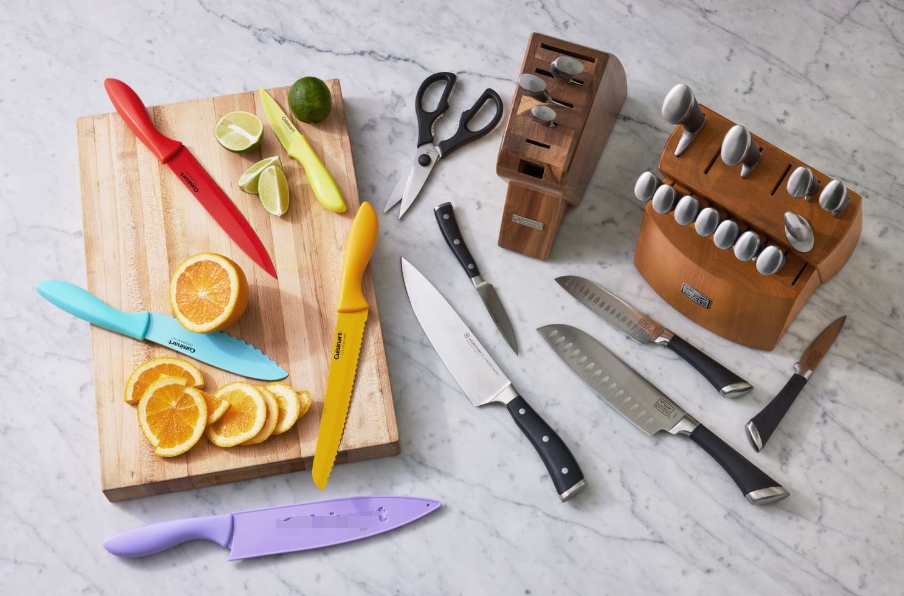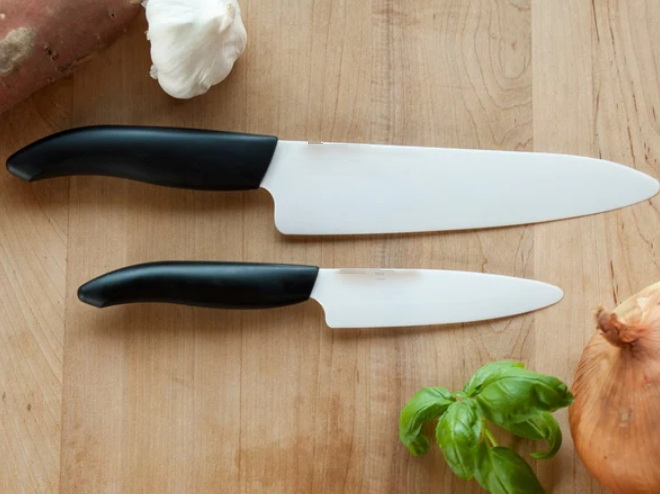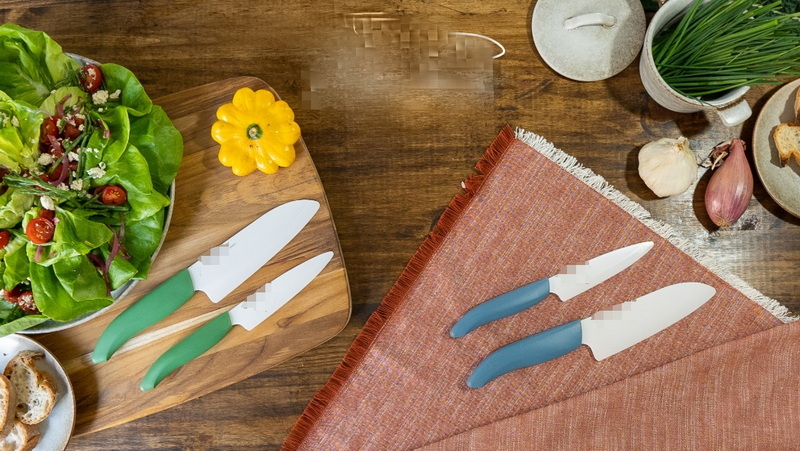

Views: 222 Author: Ella Publish Time: 2025-05-03 Origin: Site








Content Menu
● Cleaning Your Knives Properly
● Sharpening and Honing Your Knives
>> Honing: The Key to Daily Sharpness
>> Special Care for Carbon Steel Knives
● Proper Knife Storage Techniques
>> Storage Tips
>> Avoiding Common Storage Mistakes
>> Use the Right Cutting Surface
>> Handle Inspection and Maintenance
● Understanding Knife Materials and Their Care
● Signs Your Knives Need Maintenance
● FAQ
>> 1. How often should I sharpen my knives?
>> 2. Can I put my knives in the dishwasher?
>> 3. What is the best way to store knives in a drawer?
>> 4. How do I clean and maintain carbon steel knives?
>> 5. Is honing the same as sharpening?
Owning a quality knife set is an investment in your kitchen's efficiency and safety. Proper maintenance and storage are crucial to preserving the sharpness, longevity, and safety of your knives. This comprehensive guide will walk you through everything you need to know about caring for your knives, from cleaning and sharpening to the best storage methods. Along the way, you will find helpful tips, visual guides, and videos to enhance your knife care routine.

Always hand wash your knives immediately after use with mild soap and warm water. Avoid soaking knives or placing them in the dishwasher, as the high heat, harsh detergents, and agitation can damage the blade and handle. Use a soft sponge or cloth to clean the blade gently, keeping the sharp edge away from your hand to prevent injury.
After washing, dry your knives immediately with a clean, absorbent towel or paper towel. Leaving knives to air dry can cause water spots and even rust, especially on high-carbon steel blades. Make sure no moisture remains before storing your knives.
For tough stains or food residue, place the knife blade flat on a countertop with the handle off the edge, and gently scrub with the abrasive side of a sponge. This method provides control and safety while cleaning stubborn spots.
Do not use steel wool, abrasive scrubbers, or harsh detergents as they can scratch or dull the blade surface. Stick to soft cloths or sponges for cleaning.
If your knives have wooden handles, avoid soaking them in water as this can cause the wood to swell and crack. Instead, wipe the handle with a damp cloth and dry immediately. Occasionally, apply a small amount of mineral oil or specialized wood conditioner to keep the handle moisturized and prevent drying out.
Use a honing rod regularly (once or twice a week) to realign the knife's edge. Hold the honing rod vertically on a stable surface and run the knife blade at a 15-degree angle along the rod, alternating sides. Honing does not sharpen but maintains the edge between sharpenings.
Sharpen your knives every 3 to 6 months depending on usage. Use a whetstone or professional sharpening service to restore the blade's sharpness. Avoid electric or machine sharpeners that can remove too much metal or damage the blade.
- Soak the whetstone in water for about 10-15 minutes before use.
- Hold the knife at a consistent angle (usually 15-20 degrees) against the stone.
- Slide the blade across the stone in a sweeping motion, covering the entire edge.
- Repeat on both sides evenly until the blade feels sharp.
- Finish with a finer grit stone for a polished edge.
Carbon steel knives require extra attention. After washing, apply a thin layer of food-safe oil (like camellia oil) to protect the blade from rust and encourage a natural patina. Avoid cutting acidic foods without rinsing immediately afterward to prevent corrosion.

Improper storage can dull your knives, damage blades, and create safety hazards. Knives stored loosely in drawers can knock against other utensils, leading to nicks and dullness.
- Magnetic Knife Strips: Keep knives accessible and visible while preventing blade contact. Ensure the strip is clean to avoid bacterial buildup.
- Knife Blocks: Protect blades and keep knives organized. Choose blocks with slots that hold knives securely without scraping edges.
- Drawer Knife Organizers: Ideal for those with limited counter space, these keep knives separated and safe in drawers.
- Knife Sheaths or Rolls: Perfect for transporting knives or storing them safely when not in use for long periods.
- Always store knives blade-up or in a sheath to protect the edge.
- Avoid wooden blocks that are damp or dirty to prevent mold growth.
- Store different types of knives (carbon steel vs. stainless steel) separately to avoid corrosion.
- Replace knife blocks if they become worn or cracked.
- Do not store knives loosely in a utensil drawer; this leads to dulling and can cause accidents.
- Avoid stacking knives on top of each other or placing heavy items on top of knives.
- Keep knives out of reach of children by storing them in high or locked locations.
Always use cutting boards made of wood or plastic. Hard surfaces like glass, granite, or ceramic can dull your knives quickly. Wooden boards are gentle on blades and have natural antimicrobial properties, while plastic boards are easy to sanitize.
Knives are designed for cutting food, not prying open containers, cutting bones, or frozen foods. Using knives improperly can chip or break the blade. Use specialized tools like kitchen shears or cleavers when necessary.
Regularly check your knife handles for looseness, cracks, or other damage. A loose handle can be dangerous and cause accidents. If you notice any issues, consider professional repair or replacement.
When taking knives on the go, such as for camping or professional use, always use a protective case, sheath, or knife roll. This prevents damage to the blades and reduces the risk of injury.
Stainless steel knives are popular due to their resistance to rust and ease of maintenance. They require less frequent oiling and are generally dishwasher safe, although hand washing is still recommended to prolong sharpness. These knives hold their edge well but may not be as sharp as high-carbon steel.
High-carbon steel knives are prized for their sharpness and edge retention. However, they are more prone to rust and discoloration if not cared for properly. Immediate drying and oiling after use are essential to prevent corrosion.
Ceramic knives are extremely sharp and maintain their edge for a long time. However, they are brittle and can chip or break if dropped or used improperly. They do not require sharpening as often but should be handled with care.
Knowing when your knives need attention can save you from accidents and poor cutting performance.
- Dullness: If you find yourself applying more force than usual or the knife slips off food, it's time to hone or sharpen.
- Rust Spots: Visible rust or discoloration indicates improper drying or storage.
- Loose Handles: Wobbly or cracked handles can be dangerous and need repair.
- Chips or Nicks: Small chips in the blade can affect cutting precision and should be repaired by sharpening or professional service.
Maintaining knives also involves keeping safety in mind:
- Always cut away from your body.
- Use a stable cutting surface.
- Keep knives out of reach of children.
- Never try to catch a falling knife.
- Store knives securely to prevent accidental cuts.
Maintaining and storing your knife set properly ensures that your knives remain sharp, safe, and durable for years to come. Hand washing, thorough drying, regular honing and sharpening, and careful storage are the pillars of good knife care. By following these guidelines, you protect your investment and enhance your cooking experience with knives that perform at their best every time.
Remember, knives are not just tools but extensions of your culinary creativity. Treat them with respect and care, and they will reward you with precision and reliability.

Sharpen your knives every 3 to 6 months depending on how often you use them. Regular honing between sharpenings helps maintain the edge longer.
No, dishwashers can damage knives due to high heat, harsh detergents, and contact with other utensils. Always hand wash knives immediately after use.
Use a drawer knife organizer that separates each knife to prevent blades from hitting each other or other utensils, which can dull or damage them.
Wash carbon steel knives immediately after use, dry thoroughly, and apply a thin layer of food-safe oil to prevent rust. Avoid prolonged contact with acidic foods.
No, honing realigns the knife's edge and is done regularly to maintain sharpness. Sharpening removes metal to create a new edge and is done less frequently.